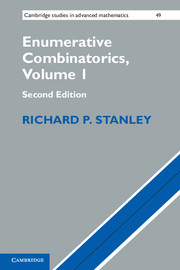4 - Rational Generating Functions
Published online by Cambridge University Press: 05 June 2012
Summary
Rational Power Series in One Variable
The theory of binomial posets developed in the previous chapter sheds considerable light on the “meaning” of generating functions and reduces certain types of enumerative problems to a routine computation. However, it does not seem worthwhile to attack more complicated problems from this point of view. The remainder of this book will for the most part be concerned with other techniques for obtaining and analyzing generating functions. We first consider the simplest general class of generating functions, namely, the rational generating functions. In this chapter we will concern ourselves primarily with rational generating functions in one variable; that is, generating functions of the form F(x) = Σn≥0f(n)xn that are rational functions in the ring K[[x]], where K is a field. This means that there exist polynomials P(x),Q(x) ∈ K[x] such that F(x) = P(x)Q(x)-1 in K[[x]]. Here it is assumed that Q(0) ≠ 0, so that Q(x)-1 exists in K[[x]]. The field of all rational functions in x over K is denoted K(x), so the ring of rational power series is given by K[[x]]∩K(x). For our purposes here it suffices to take K = ℂ or sometimes ℂ with some indeterminates adjoined.
The fundamental property of rational functions in ℂ[[x]] from the viewpoint of enumeration is the following.
- Type
- Chapter
- Information
- Enumerative Combinatorics , pp. 464 - 570Publisher: Cambridge University PressPrint publication year: 2011



